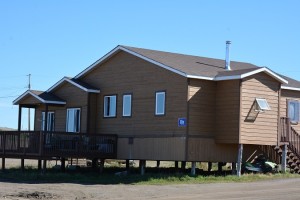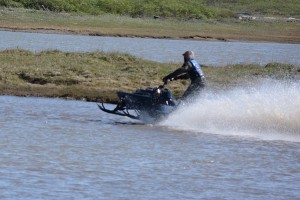
A Town on the Arctic Coast of Canada
Tuktoyaktuk
Updated Apr 2022
 Tuktoyaktuk is a village on the coast of the Arctic Ocean in Canada. It has a population of about 950. About 80% of the population is Inuvialuit. (Formerly known as Eskimos but they have reverted to their original name instead of the one that white people gave them).
Tuktoyaktuk is a village on the coast of the Arctic Ocean in Canada. It has a population of about 950. About 80% of the population is Inuvialuit. (Formerly known as Eskimos but they have reverted to their original name instead of the one that white people gave them).
The village has two grocery stores but no restaurants. Many people still supply their meat by fishing and hunting. Food in the stores is extremely expensive because everything arrives by air except for large items which come in summer by ship.
While walking around Tuktoyaktuk (Tuk for short), one thing that you will notice is that all the houses and other buildings are above ground level. Below the ground is a layer of permanent ice, even during the hot days of summer. Although the ice never totally melts, it melts and re-freezes enough to change shape. If you built a house on the ground, it would soon be on a slant. Therefore, posts are driven down through the ice to solid earth below the permafrost; and the buildings rest on these posts.
There is no municipal plumbing in Tuk. If you look closely you will see that each building has a large pipe sticking out of it. Water is brought to each house by truck from a very large holding tank. This tank is filled from lakes during summer and holds enough water to last all winter. The water is then purified and put into trucks for distribution.
The Community Freezer
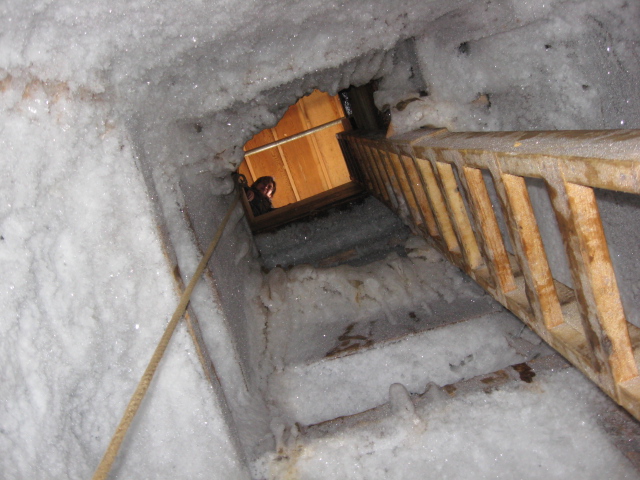

Tuktoyaktuk is an interesting place. The village has an underground community freezer. Access to the freezer is by ladder, going down nine metres below the surface. At the bottom of the ladder, you can go into one of three tunnels. Each tunnel has several rooms off to the sides. Fishermen store their catch here. It remains frozen all year round without the use of electricity. The freezer was dug out of the earth, by hand, many years ago. Today, many people choose the convenience of ordering an electric freezer for their home instead of using the underground freezer, even though an electric freezer has the added expense of shipping in by barge from the south as well as an increase in their electric bill. However, many fishermen still used the free underground freezer.
The tunnels in the community freezer are beautiful. The roof and the sides, about halfway down, are covered in ice crystals. On the lower half of the walls, one can see a series of lines in the ice, where different layers of ice have formed. This is difficult to explain – look at the photos.
Skipping
One of the pastimes that younger people have in Tuktoyaktuk is called “skipping”. This involves driving a snowmobile over open water. Surprisingly, they do not sink, as you might think. As long as you go fast enough and start and end your trip on land or ice, you will be ok. If you stop or go too slow, the snowmobile will sink. I saw this in Tuk and also on the MacKenzie River. Snowmobiles can travel long distances on water. The best way to describe this is with a question and an analogy. Do stones float or sink? Obviously, stones do not float, but if you throw a flat one at the right angle and with enough speed, it will skip along the surface of the water until it loses momentum, before sinking.
Skipping can be dangerous. One young person drowned just a few days before I arrived in Tuk when his snowmobile broke through the ice and sank.
Pingo National Landmark
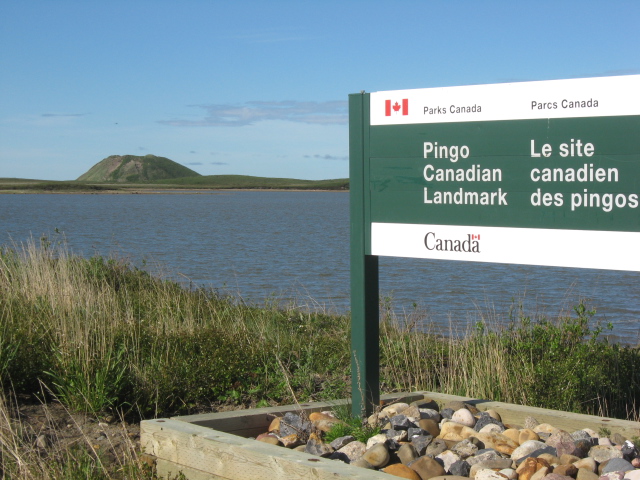

Another fascinating attraction in Tuktoyaktuk are the Pingos. They look like large hills on the Arctic tundra, but they are filled with ice, not dirt. If you live in Canada or the northern United States or Scandinavia, you will be familiar with ice heaves. Ice melts and freezes, depending on the temperature. As ice takes up more space than water, sometimes the ice pushes the surface upward. This can result in bumps or cracks in the road.
In the Arctic, ice heaves, are taken to the extreme. Some of them are 70 metres (230 feet) tall. Underground water freezes during the winter and pushes the surface upward. During summer, the temperature is warm enough for more water to enter and the next winter, when it freezes again, the ground is pushed further upward. Pingos exist only in the high Arctic in Canada, Alaska, Greenland, Russia and the Norwegian island of Spitsbergen. Pingos grow by only a couple of centimetres per year, so one that is 70 metres tall has taken hundreds of years to form.
Pingo National Landmark
A park called Pingo National Landmark, near Tuktoyaktuk was created to protect eight pingos from being damaged by all-terrain vehicles or excavation. One of the Pingos, called Ibyuk Pingo, is Canada’s largest and the second largest in the world. The largest one is in Alaska. A National Landmark, is something like a National Monument in the United States. Similar to a National Park, but lower in status, as they do not receive enough tourists or federal funds to be a National Park. Landmarks in Canada and Monuments in the U.S.A. are part of the federal park services, like a National Park. Pingo is Canada’s only National Landmark. Ibyuk continues to grow at a rate of about two cm (about 0.79 inches) per year and is estimated at more than 1,000 years old. If you don’t know what they are, you might think it is just a hill; but the Arctic tundra is flat and treeless and does not have hills like a pingo.
Mosquitoes
No story about Tuktoyaktuk would be complete without mentioning the mosquitoes. To say that they are abundant would be an understatement. They are also very aggressive. Tuk has a population of more than 900 people but you will not see a lot of them on the streets. I did see some children playing outdoors but most people stay in their houses except when it is necessary to go out. When they do venture out, they usually wear hoodies because of the mosquitoes. It was a warm day but I wore a light jacket and gloves and a hat with head netting. If you come to Tuk make sure you bring mosquito protection. Insect repellent is ok for short outings. It is better to have a head net and even better to have a whole jacket made of mosquito netting.
The Mackenzie Delta


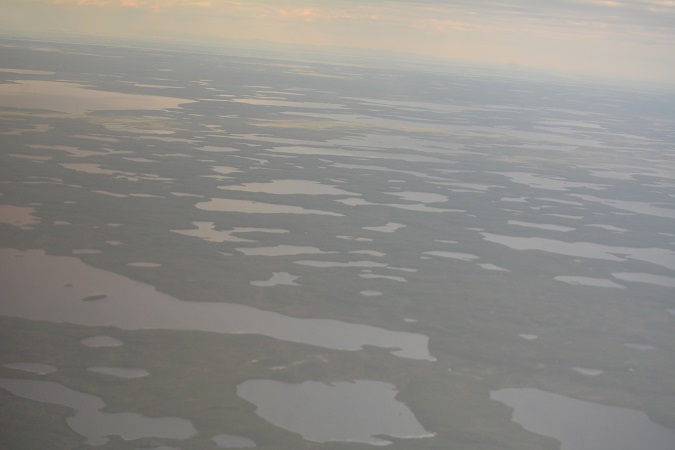
The terrain between Inuvik and Tuktoyaktuk is the MacKenzie Delta where the Mackenzie River meets the Arctic Ocean. The area is a maze of channels as the river splits into many different routes. On either side of the river, are thousands of lakes. There are several small lakes per kilometre and some larger ones.
The Road to Tuk
Now you can drive right up to the coast of the Arctic Ocean. It is the only road in North America where you can do this. There is a road in Alaska (called the Dalton Highway) but it stops at the Prudhoe Bay oil refinery and the only way to proceed further is a bus tour of the refinery. You will be only a few miles from the coast but you cannot drive your vehicle any further. The roads at Prudhoe Bay are private roads owned by the oil company. Another drawback of the Dalton Highway is a large amount of truck traffic going to and from the oilfields. Driving the Dempster to Tuktoyuktuk is a much better option.
This section of the highway from Inuvik to Tuktoyaktuk had been in the planning stage for decades. It finally opened in November 2017. Technically, this is not part of the Dempster Highway. Officially the name is Northwest Territories Highway 10. The locals call it the Inuvik to Tuktoyaktuk Highway. Tourists just see it as the last leg of the Dempster.
There are three bed-and-breakfast establishments in Tuktoyaktuk called Tuktu, Smitty’s and Hunter’s. No campground yet but one is proposed. In the meantime, people with RVs can camp at a place called “The Point” which is the end of the road at the Arctic Coast. It is not a campground and no facilities are available but you are welcome to camp there.
The Trip of a Lifetime
A road trip to the Arctic coast is an adventure and a trip of a lifetime off the beaten path that you will never forget. You can read about the whole trip from Dawson to Tuktoyaktuk on this website.
